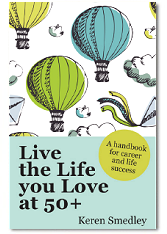Keren Smedley 8th August 2016
Simple techniques that can help to reduce anxiety
 Many of us find as we get older we worry more. If something minor happens, we assume it’ll develop into a disaster. We often feel more vulnerable and less in control so that the consequences of something bad happening will be harder to shrug off; for example: ‘If I fall, I’m more likely to break a bone and then I’ll be off work and short of cash. But I need to go for food. I could ask one of my children but I don’t want to be dependent on them’, and so on and so on.
Many of us find as we get older we worry more. If something minor happens, we assume it’ll develop into a disaster. We often feel more vulnerable and less in control so that the consequences of something bad happening will be harder to shrug off; for example: ‘If I fall, I’m more likely to break a bone and then I’ll be off work and short of cash. But I need to go for food. I could ask one of my children but I don’t want to be dependent on them’, and so on and so on.
We behave when we’re in this kind of state, as though we have no control over our thoughts. This type of thinking can be a habit. When we become anxious, our bodies, not knowing any better, get ready to deal with the impending disaster. Fear can be paralysing, we feel panicked and stuck. When we’re frightened or alarmed by either an external factor or something in our head, a physiological response is triggered in our body. This is known as the flight or fight response. If you were to meet a lion on a street corner, you’d know to run! When we perceive stress it activates our pituitary gland releasing Adrenaline and Noradrenaline into our system. This causes our body to go into a flight or fight mode and puts us on alert. It also tells the adrenal glands to get busy and to produce Cortisol. Cortisol is a hormone which helps us deal with stress and is meant to act for a short time. When we’re stressed it remains in our body leading to fatigue, increased blood pressure and many of the negative side effects of being stressed
Simultaneously, danger stimulates our autonomic nervous system – a second unconscious automatic nervous system – to release noradrenalin and adrenalin itself. These in turn tell other parts of our body to react so our pupils dilate, our heart rate increases, our breathing becomes faster and shallower, insulin is released into our blood system, our blood pressure rises, our palms sweat, blood is diverted away from our digestive system and skin and our muscles tense.
Sometimes fear can be useful if it is alerting us to danger giving us an opportunity to avoid it. However, our bodies don’t always know how to distinguish between real danger and imagined threats. If you have this reaction when no physical action is needed – for example, feeling nervous when you’re seeing an old friend who you haven’t seen for ages – you have no choice but to suppress it. What follows is a build-up of anxiety, which is no good for your health or emotional state. It leaves you panicked and without the ability to make choices.
There are some very simple techniques that can help to reduce anxiety and help you to become calm. Try the exercise below:
When you’re getting really worked up:
- Say, ‘Stop!’ firmly to yourself – aloud if the situation permits, mentally if not.
- Breathe in, becoming aware of your jaw and shoulders as you do so. Breathe out slowly, making the exhalation longer than the inhalation, allowing your shoulders and jaw to relax as you do so. Mentally say to yourself, ‘Let go.’
- Breathe in, focusing your awareness on your chest, arms and hands. Breathe out slowly, relaxing your chest, arms and hands as you do so. Mentally say, ‘Let go.’
- Breathe in, focusing your awareness on your stomach muscles, thighs and buttocks. Breathe out slowly allowing stomach muscles, thighs and buttocks to relax as you do so. Mentally say, ‘Let go.’
Be aware only of breathing out slowly; the body will automatically breathe in for you. Mental stress will lessen when you relax the muscles and slow your breathing.
Please take a look at this link: Nuskin and look at cortitrol. Many people find this really helpful. If you want to know more please send us a message and Susie will get back to you .
Share this ..


